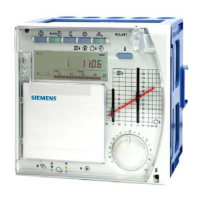59/118
Siemens Heating and D.h.w. Controller RVL481 CE1P2541en
Building Technologies 14 Function block "District heat" 20.05.2008
T
PR
T
A
s
90
80
70
60
50
40
30
20
20
10 0
-10
30
T
L constant
T
L start
2381D03
s Slope of limitation (operating line 112)
TA Actual outside temperature
T
L constant
Constant value of limitation (operating line 101)
.
T
L start
Start of shifting limitation (operating line 113)
T
PR
Primary return temperature
The outside temperature is used as a compensating variable for maximum limitation of
the primary return temperature. It can be delivered either by the local sensor or the
LPB.
Limitation operates according to the selected characteristic:
• When the outside temperature falls, the return temperature will initially be limited to the
constant value
• If the outside temperature continues to fall, it will reach the selected starting point for
shifting compensation. From this point, the limit value will be raised as the outside
temperature falls. The slope of this section of the characteristic can be adjusted.
Maximum limitation of the return temperature has priority over minimum limitation of the
flow temperature.
This function can be deactivated on operating line 101.
If the return temperature is limited, the display shows
.
14.2.2 Maximum limitation of return temperature differential
(DRT limitation)
For the differential of primary return and secondary return temperature, a maximum
limitation can be set. For this purpose, a temperature sensor (sensing element
LG-Ni 1000) is required in the secondary return.
If the differential of the two return temperatures exceeds the adjusted maximum limit,
the flow temperature setpoint will be reduced.
DRT limitation has priority over minimum limitation of the flow temperature.
This function can be deactivated (setting --- on operating line 115).
If DRT limitation is active, the display shows
.
With plant types 3–1, 3–3, and 6–x, DRT limitation is not active during d.h.w. heating.
Limitation of the return temperature differential
• prevents idle heat resulting from excessive cooling down (no unnecessary return
supply of heat to the utility)
• optimizes the volumetric flow
• is a dynamic return temperature limitation
• shaves peak loads
• ensures the lowest possible return temperature
Function
Function
Action during d.h.w.
heating
Purpose

